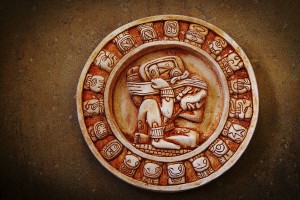
A carved Mayan calendar on textured background. Despite the provisional nature of calendars, two real phenomena govern almost all of them: the phases of the moon and the rotations of the sun. PHOTO: ISTOCK
Every four years on Feb. 29, we are reminded of one of life’s most puzzling conundrums: Time is both arbitrary and immutable. The “leap” making its appearance this Monday shows that the Western calendar on which we place so much reliance is a conceit—a piece of fiction introduced by Pope Gregory XIII in October 1582.
Despite the provisional nature of calendars, two real phenomena govern almost all of them: the phases of the moon and the rotations of the sun. Our Mesolithic ancestors were the first people to harness the movements of the cosmos to provide a fixed notion of the past, the present and the future. The oldest known calendar in the world was discovered in a Scottish field in 2013, notched into the earth some 10,000 years ago. Our forebears had created it by shaping 12 specially dug pits around a 164-foot arc to mimic the phases of the moon and track the months. Continue reading…





